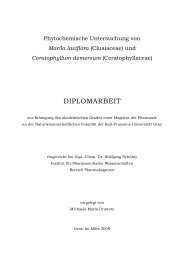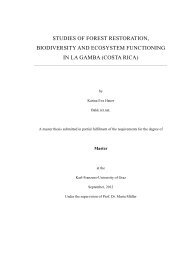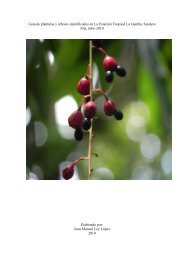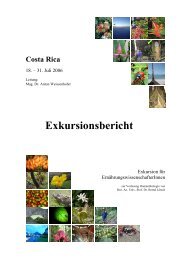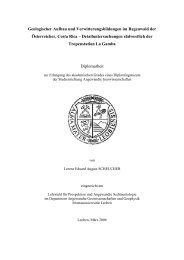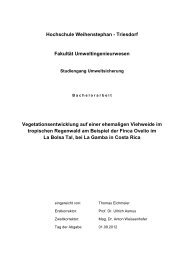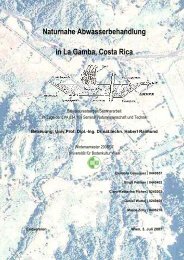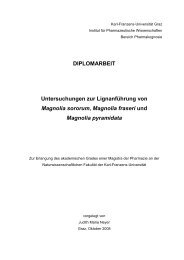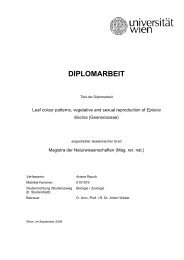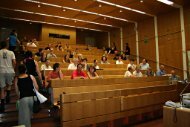Die Tropenstation La Gamba
Die Tropenstation La Gamba
Die Tropenstation La Gamba
Erfolgreiche ePaper selbst erstellen
Machen Sie aus Ihren PDF Publikationen ein blätterbares Flipbook mit unserer einzigartigen Google optimierten e-Paper Software.
<strong>Die</strong> „<strong>Tropenstation</strong> <strong>La</strong> <strong>Gamba</strong>“ in Costa Rica – Wissenschaftlicher Bericht<br />
GUEVARA, MIGUEL G., May 1999: The Abundance and Population Struture of Some<br />
Economically Important Trees in Piedras Blancas National Park, Costa Rica.- For<br />
the degree of Master of Science, University of Montana. Montana<br />
The abundance and population structure of Brosimum utile, Calophyllum brasiliense,<br />
Carapa guianensis, Peltogyne purpurea, Qualea paraensis, Schizolobium parahyba,<br />
Symphonia globulifera, Tachigali versicolor, Terminalia amazonica, Vantanea<br />
barbourii and Vochysia hondurensis were studied in primary well-drained wet forest of<br />
Piedras Blancas National Park, Costa Rica. Seventy five plots, each 0,04 ha were<br />
established along three transects between 50 and 400m elevation. In each plot the<br />
abundance and population structure of each species were determined by recording the<br />
total number of individuals of all trees ≥2,5 cm dbh. Three types of diameter-size class<br />
distribution were recognized. Type 1, represented by five species ( Brosimum utile,<br />
Calophyllum brasiliense, Carapa guianensis, Symphonia globulifera, and Tachigali<br />
versicolor), is typical of climax forest (shade tolerant species), showing a characteristic<br />
inverse J-shape. Type 2 represented by five species ( Qualea paraensis, Schizolobium<br />
parahyba, Terminalia amazonica, Vantanea barbourii and Vochysia hondurensis), is<br />
typical of „gap“ or „light demanding species“. Type 3 represented by one species (<br />
Peltogyne purpurea) is intermediate between the more shade-tolerant and light<br />
demanding species. Brosimum utile, a Type 1 species, is the most abundant and<br />
dominant species in PBNP and displayed an average density of 27 individuals ≥ 2,5 cm<br />
dbh and basal area of 3,22m². In general, shade-tolerant species were more dominant and<br />
widepsread in PBNP than light demanding species and the lattered tend to have a patchy<br />
distribution. Tachigali versicolor, another abundant and widlely distributed species, is a<br />
monocarpic wind-dispersed (large seeds) long-lived canopy species in which trees die<br />
within one year after producing a fruit crop. PBNP appears to be a dynamic site when<br />
compared to other areas in the Golfo Dulce-Osa Peninsula. Natural disturbances such as<br />
wind, lightening, floods, mudslides and tree fall in conjunction with steep topography<br />
open gaps for light-demanding species.<br />
Anschrift des Autors:<br />
Miguel Guevara Gonzáles<br />
University of Montana<br />
Missoula, MT 59812-0002<br />
67



